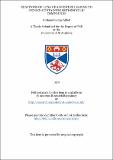Reactions of long chain esters leading to oxygen-containing heterocyclic compounds
Abstract
With the intention of preparing long chain esters containing a carbocyclic system, methyl linoleate and related esters were subjected to strongly acidic reaction conditions. The major product of the reaction, however, was shown to be a mixture of isomeric 1,4-epoxidea (tetrahydrofurans) and for comparison, a mixture of the cis and trans 9,12-epoxidos was prepared by an unambiguous synthesis. The discovery of those hotorocyclic fatty esters prompted further investigations into their methods of preparation. The cyclodehydration of some trihydroxyacids containing a 1,4-diol system was examined and the mechanism of the reaction elucidated. Those studies led to the formulation of the absolute configurations of the 9,12,13-tri-hydroxystearic acids. Methyl ricinoleate and methyl 9-hydroxyoctadec-cis-12- enoate were found to give different types of product when epexidised, The former yielded the expected 1,2-epoxide, whilst the latter furnished a mixture of hydroxytetrahydrofurans (90%). Since it was evident that the second reaction involved participation by the hydroxyl function, other epoxidation Reactions of various hydroxy, oxo and acetylenic ostors were investigated. The results indicated that oxo and hydroxy functions can interact with a proformed epoxide to yield cyclic products. Finally, various unsubstiuted 1,4-opoxidos were prepared by free radical oxidations of some hydroxyostors. Both load totraacotate and metal oxido-halogon mixtures were used as oxidising agents.
Type
Thesis, PhD Doctor of Philosophy
Collections
Items in the St Andrews Research Repository are protected by copyright, with all rights reserved, unless otherwise indicated.

